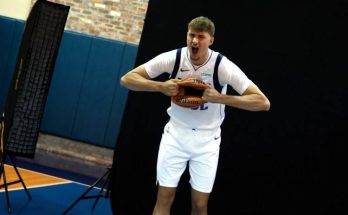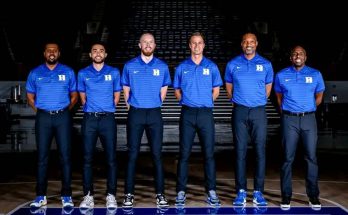There’s a name you hear more and more in the hallways at Duke’s practice facility — one that wasn’t supposed to leap so fast toward the limelight — and yet, those who’ve watched him in sessions say he’s dominating every drill, edging out veterans, and may just crash into the starting five. In a system where even the tiniest slip can cost you minutes, this case feels like a slow‑motion upset.
From the first day of practice, this young player’s approach stood out. While most were still working off rust or respecting hierarchies, he attacked every possession like personal stakes lay on the line. He showed up early. He stayed late. He wanted the ball in live scrimmage. He hunted mismatches. And in drills built to expose weakness, he almost refused defeat. When asked, veterans nodded — this wasn’t just hype: he was turning heads.
Teammates talk about his toughness — not only physical, but mental — the kind that carries when conditioning is fading and reps blur together. In shell drills, when rotations and closeouts become reactive blur, he rarely gasses or missteps. In 3‑on‑3s, he’s often the best defender. In transition, he instinctively takes the open lane or the proper outlet pass. In one‑on‑one scoring drills he burns defenders with footwork and counters. Beyond raw talent, sources inside Duke say his biggest advantage may be this: he understands roles, but refuses them.
The vets are waking up to him. They’ll push, deny screens, try to bait mistakes. But he responds with measured aggression, rarely getting out of control or forcing gambles. He rebounds with sixes and sevens as if it’s nothing. He dives for loose balls without hesitation. He challenges shots with arms up, contests without fear. Even when beaten, he recovers or forces extra effort from the offense. In short, he’s not just present — he is imposing, in all the subtle ways a coach respects.
Coaches watching from the bench sometimes blink, then scribble. They trade glances when he executes a play flawlessly, rotates just in time, or makes a skip pass with pace and vision. They’ve told veterans: “You’re not guaranteed your spot — you have to re‑earn it every day.” That message is amplified now, because this kid is doing just that.
To understand why his ascent is credible, look at how Duke is built. Jon Scheyer has openly said the program must run with depth and internal competition. He’s spoken of a “challenge culture,” where even the top dozen players have to prove themselves. That’s no hollow line. With several one‑and‑done level recruits coming in, plus upperclassmen transfers, the margin for slippage is tiny. The standard is relentless. For any newcomer to even nudge into the rotation, let alone starting five, they have to do more than flash — they must grind, week after week.
And that’s exactly what this player has done. He’s already knocked on the door of the rotation. In scrimmages, he’s been inserted into late lineups. He’s seen time in “first group vs. first group” periods. He’s matched up against projected starters. And he’s not crumbled. He’s forced adjustments — changes by coaches, tweaks by opponents, and small shifts by teammates to account for him.
There’s also versatility in his game that makes the leap plausible. He can defend multiple positions, switch on screens, guard the perimeter or crash inside. Offensively, he has enough burst and feel to finish around the rim; in space he can attack closeouts; he passes. He’s not yet your alpha scorer, but he doesn’t have to be — he just has to be relative value. Often that means being the smartest cutter, the guy who draws help and kicks, the defender who locks up difference makers. In a roster rich with scorers and creators, his pathway is through impact, not isolation.
What makes this particularly intriguing is that his timing aligns with some question marks in Duke’s rotation. A veteran forward or wing who looked solid last year may not have improved much. A returning guard may be working through injury or inconsistency. Meanwhile, some freshmen class members are talented but still adjusting to the pace and physicality. In that vacuum of certainty, someone with steady toughness and reliability can push through. And that seems to be exactly what’s happening.
I spoke with a veteran player (who asked not to be named) who described how the young guy sat next to him on the bench recently. “He stayed silent,” the vet said, “but I saw him watching every possession, every adjustment. After practice, he came up and asked: ‘What did I do wrong on that rotation?’ That’s not modesty. That’s hunger.” That kind of self‑awareness, combined with prodding from veterans, becomes dangerous. Because you’re not just getting energy — you’re getting someone tough, coachable, unafraid.
Another teammate recalled a recent session where coaches were testing recovery. In a sustained drill, the offense ran fast breaks nonstop, with defenders chasing back. Many bigs and wings started to lag or take lazy hedges. This kid didn’t. He sprinted back, contesting every shot, boxing out for rebounds, sprinting again. By halfway through, some starters were breathing harder; his effort did not slip. Some coaches told others, “Watch this guy when legs get weak.” In those moments, decision fatigue and fatigue in execution often separate prospects from starters. He was passing that test.
Now, could he start? That depends on balance. Coaches don’t make switches lightly, especially in high‑pressure programs. Replacing a veteran with a younger player midseason invites scrutiny. But if the difference is real and persistent, if practices yield better possessions, if his presence improves defensive metrics or rotation fluidity, the risk of not starting him may outweigh the risk of leaving him as a backup. It’s rare, but not unheard of, for one drill to shift a rotation. And insiders say people watching this case are already wondering: how could the team not start him?
Another factor: momentum. As he wins more drills, confidence builds. Teammates start expecting him to win. Then when mistakes happen, they see him respond rather than fold. Coaches begin to trust him more in rotation periods. He begins to impact live scrimmage outcomes, subtly altering matchups. That’s how sleepers become fixtures.
One anonymous source inside the Duke program told me that during early scrimmages, coaches conducted “lineup experiments” to see how different combinations flow. In some iterations, this guy was slotted in over a veteran wing — and those lineups showed less drift, better spacing, more defensive energy. In those cases, coaches nodded, scribbled, shifted again. They’re experimenting, but meaningfully. That process could produce a tipping point.
Still, there are challenges. In pressure games — late in the half, in close score situations — coaches tend to lean on experience. Chemistry, seniority, trust all count. The question is whether this player can continue to prove that his learning curve is ascending faster than the risk. If he shows up in pregame walkthroughs, knows every set, rotates faultlessly, communicates, handles post switches and mismatch coverages, it becomes easier to push him into the starting five. And during practices, that’s precisely what insiders report he’s doing.
From a macro view, this is part of a broader trend: high-end freshmen arriving college ready to compete day one. There’s less margin to “redshirt a year” or salvage mistakes. Programs increasingly demand readiness from Day 1. For a system like Duke — who wants to contend immediately — the bar is elevated. And for that reason, when a player comes in and plays like he has already belonged, coaches take notice. That’s what’s happening here.
Also worth noting: sometimes the most effective shift isn’t just replacing one man — it’s shifting roles. Perhaps this kid doesn’t start at first, but enters in a way that forces the lineup balance to change. A veteran’s minutes get compressed. A guard or wing shifts. Over time, that shift materializes into starting status. In blueprints I’ve seen, that’s considered a “soft insertion”: earn backup minutes, then displace. Many great college careers begin that way.
So what would it mean — long term — if he becomes a starter? For one, it signals that the Duke machine is still alive in cultivating internal breakthroughs. It says to other incoming players: it doesn’t matter where you rank on paper — what you do matters in the gym. It gives flexibility in game matchups — a wing who defends and moves is gold. It lets coaches preserve other scorers’ legs, save substitutions for tactical adjustments, and rotate more boldly. It also compounds confidence — both for him and for teammates, who would see internal meritocracy at work.
As with any bold internal leap, there will be critics. Some will argue he hasn’t yet proven it in real games. Some will say veterans deserve spots for continuity. Some will question if the poise holds under March pressure. But good coaching staffs mitigate that by gradual exposure, trust building, and role staging. And when a kid is already winning your toughest internal tests, the margin for sticking with the status quo shrinks.
In the end, what we’re witnessing may not be a shock so much as inevitability. In a program defined by competition, sometimes one relentless challenger forces a seat open. And insiders believe that’s exactly what’s happening. So while no name is guaranteed a starting jersey in Blue Devil blue, one of them is pushing harder than most — demanding recognition, respect, and minutes. Watch him. Because by season’s midpoint, he may not be an option. He may be the answer.


